|
 Gomphus novae-zelandiae Gomphus novae-zelandiae
SynonymsGloeocantharellus novae-zelandiae
BiostatusPresent in region - Indigenous. Endemic
Images (click to enlarge)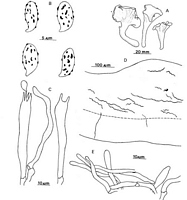
Caption: Fig. 1 Gomphus novae-zelandiae. A, habit; B, spores; C, basidia with gloeoplerous hyphal
ending; D, V.S. of pileus (context above and hymenium below) showing gloeoplerous hyphal
system; E, V.S. pileipellis. | 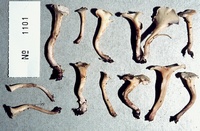
Caption: ZT1101
Owner: E. Horak: © Creative Commons Attribution-Noncommercial 3.0 New Zealand | 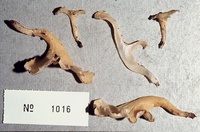
Caption: ZT1016
Owner: E. Horak: © Creative Commons Attribution-Noncommercial 3.0 New Zealand | 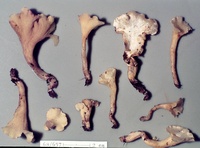
Caption: ZT68-657
Owner: E. Horak: © Creative Commons Attribution-Noncommercial 3.0 New Zealand | 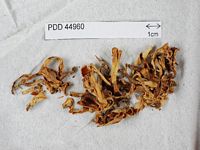
Caption: Dried type specimen
Owner: Herb PDD |
Article: Segedin, B.P. (1985) [1984]. Two new species of Gomphus Pers. (Aphyllophorales) from New Zealand. New Zealand Journal of Botany 22(4): 533-537 (http://www.rsnz.org/publish/abstracts.php).
Description: Basidiomes thin fleshy, 35-70 mm in height, mainly mesopodal but sometimes slightly
pleuropodal or tending towards merismatoid, turbinate, 20 mm wide at the top, tapering
gradually to 3 mm at base, or tapering more sharply to a distinct stipe. Pileus 12-28 mm
diam., dull ochraceous to pale salmon, shallow depressed to widely infundibuliform, and
sometimes perforate, fleshy, dry, matt to velvety; margin straight to slightly incurved,
becoming more or less undulate, fairly thin; flesh at edge of pileus turns reddish on cutting
but not on bruising. Stipe 3-6 mm diam., very variable in length (5-50 mm) depending on
shape of fruiting body, cylindrical to flattened or grooved, hollow, velvety, concolorous with
pileus, staining reddish on bruising. Hymenial surface deeply decurrent, slightly darker than
pileus, is almost smooth or with distant, very shallow, lamellar folds, not intervenose. Flesh
ochraceous, soft. Colour of fruiting body changes very little on drying. Smell not noticeable,
taste slightly bitter. Reactions: KOH yellowish; FeSO, purplish black to black. Hyphae of
pileal surface thin-walled (walls yellowish), 3-6 µm diam., clamped, with narrower upturned
ends. Hyphae of context up to 10 µm diam., thin-walled, more or less parallel and tightly
interwoven, not inflated, clamped; gloeoplerous hyphae scattered but more frequent near the
hymenium, tortuous, occasionally branched, rarely septate but clamped, forming inflated
coils, contents yellow in bright field, strongly cyanophilic, not colouring in sulphovanillin,
but becoming conspicuously broken into droplets or bars in the strong acid; some
gloeoplerous elements end among the basidia to form tortuous pseudocystidia. Hymenium
thickening, basidia long, 70 x 6-10 µm, clavate, clamped, 1-2-4-sterigmate, sterigmata up to 8
µm. Stipe of narrow, parallel, clamped hyphae with some gloeoplerous hyphae like those
of the context; caulocystidia numerous, clavate, hyaline, 30 x 5-6 µm. Spore print
tobacco brown. Spores 9-11.5 (9.7) x 4-5 (4.3) µm, ellipsoid to tear-shaped, pale
yellow-brown in bright field; walls moderately thick, verrucose to finely waned,
ornamentation deeply cyanophilic after 24 h in lactic blue; apiculus prominent,
rounded; spore wall metachromatic; faintly dextrinoid.
Habitat: HABITAT: gregarious in mixed podocarp-broadleaf forest, New Zealand.
Notes: G. novae-zelandiae is a relatively small, fragile species with an almost smooth
hymenium, found in litter under various trees in mixed podocarp-broadieaf forest.
The genus Gomphus has been variously subdivided into subgenera and sections by
different authors (Corner 1966, 1969; Petersen 1968, 1971 a, b, 1976). G. novae-zelandiae
would be placed in Petersen's (1971 a) subgenus Gomphus on the basis of
smooth pileus and presence of clamp connections.
|